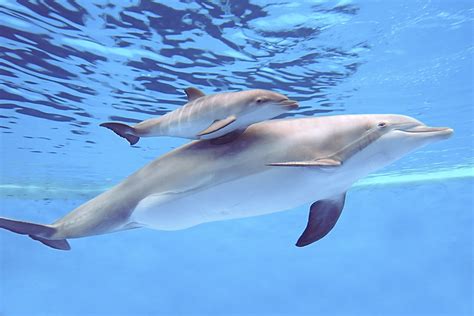
A bottlenose dolphin calf was born at the Brookfield Zoo in Chicago on Sunday, marking a significant moment captured on video. The heartwarming event saw another female dolphin assisting the mother, Allie, in bringing the newborn to the surface for its first breath, highlighting the cooperative nature of these marine mammals.
The Chicago Zoological Society, which manages Brookfield Zoo, announced the successful birth, emphasizing the role of experienced staff and the supportive social structure within the dolphin community. “The birth of Allie’s calf is a significant milestone for the Brookfield Zoo and the broader conservation efforts surrounding bottlenose dolphins,” stated a representative from the Chicago Zoological Society. “It allows us to further study dolphin behavior, maternal care, and social dynamics, all of which contribute to the well-being of dolphins in both managed care and natural environments.”
The birth occurred in the Seven Seas exhibit, a specially designed habitat that simulates the natural environment of dolphins. The zoo’s marine mammal staff closely monitored Allie throughout her pregnancy, providing specialized care and ensuring optimal conditions for the delivery. The gestation period for bottlenose dolphins typically lasts around 12 months, during which the mother undergoes significant physiological changes to support the developing calf.
According to the zoo, Allie went into labor early Sunday morning, and the experienced animal care team was on hand to provide support. The birth process unfolded naturally, with Allie exhibiting typical maternal behaviors. One notable aspect of the birth was the presence and assistance of another female dolphin, who helped guide the newborn to the surface to take its crucial first breath.
“Dolphins are known for their strong social bonds and cooperative behavior, particularly among females,” explained Dr. Rita Rossi, a marine mammal biologist at the zoo. “The assistance provided by the other female dolphin is not uncommon and demonstrates the complex social structure that exists within dolphin communities. This behavior ensures that the calf receives immediate help in those critical moments after birth.”
The first few days are critical for the newborn calf as it adjusts to its new environment and establishes a strong bond with its mother. The marine mammal staff is closely monitoring Allie and her calf, observing their behavior, nursing patterns, and overall health. The calf, whose sex has not yet been determined, appears to be nursing well and bonding with Allie.
“We are extremely pleased with the progress of both Allie and her calf,” said Michael Adkesson, Vice President of Clinical Medicine for the Chicago Zoological Society. “The first few days are always the most critical, and we are encouraged by the strong bond we’re seeing between mother and calf. Our team is dedicated to providing them with the best possible care and ensuring their well-being.”
The birth of the dolphin calf at Brookfield Zoo is not only a joyous occasion but also an opportunity for education and conservation. The zoo plans to use this event to raise awareness about the threats facing wild dolphin populations, including habitat loss, pollution, and entanglement in fishing gear. By educating the public about these challenges, the zoo hopes to inspire action to protect dolphins and their ocean environment.
The calf’s arrival has already generated considerable excitement among zoo visitors and online communities. The video of the birth, which shows the other female dolphin aiding Allie and the newborn, has gone viral, attracting viewers from around the world. This heightened interest provides a platform to highlight the importance of marine conservation and the role of zoos in protecting endangered species.
“Zoos play a vital role in conservation by providing safe havens for animals, conducting research, and educating the public,” stated a spokesperson for the Association of Zoos and Aquariums (AZA). “The birth of the dolphin calf at Brookfield Zoo is a testament to the zoo’s commitment to animal welfare and conservation efforts.”
The Brookfield Zoo actively participates in collaborative research projects with other institutions and organizations to study dolphin behavior, health, and genetics. These studies contribute to a better understanding of dolphin biology and inform conservation strategies. The data collected from dolphins in managed care can also be applied to the conservation of wild populations.
One of the key areas of research focuses on understanding the impact of human activities on dolphin populations. Pollution, noise, and habitat destruction pose significant threats to dolphins in many parts of the world. By studying the effects of these stressors on dolphins in managed care, researchers can develop strategies to mitigate their impact on wild populations.
The zoo also supports field conservation projects aimed at protecting dolphins in their natural habitats. These projects include efforts to reduce entanglement in fishing gear, monitor dolphin populations, and protect critical habitats. By working with local communities and organizations, the zoo is helping to ensure the long-term survival of dolphins in the wild.
The birth of the dolphin calf serves as a reminder of the importance of protecting marine ecosystems and the incredible diversity of life they support. Dolphins are intelligent and social animals that play a vital role in the marine food web. Their conservation is essential for maintaining the health and balance of ocean ecosystems.
The Brookfield Zoo is committed to continuing its conservation efforts and inspiring future generations to care about marine life. Through educational programs, exhibits, and research, the zoo aims to empower individuals to take action to protect dolphins and their ocean environment. The birth of the dolphin calf is a symbol of hope and a reminder of the potential for conservation success.
The public eagerly awaits the opportunity to see the new calf in person, but the zoo advises that viewing opportunities will be limited initially to allow Allie and her calf to bond and adjust to their surroundings. Updates on viewing schedules and other information will be posted on the zoo’s website and social media channels.
Frequently Asked Questions (FAQ)
1. When was the dolphin calf born at Brookfield Zoo?
The bottlenose dolphin calf was born on Sunday morning at the Brookfield Zoo in Chicago. The exact date in 2024 was not specified in the article, but the birth occurred in the Seven Seas exhibit.
2. Who is the mother of the dolphin calf, and who helped her during the birth?
The mother is Allie, a bottlenose dolphin at the Brookfield Zoo. Another female dolphin assisted Allie during the birth by helping the newborn calf to the surface to take its first breath.
3. Why is the birth of the dolphin calf significant for the zoo and conservation efforts?
The birth is significant as it allows the Brookfield Zoo to further study dolphin behavior, maternal care, and social dynamics, contributing to the well-being of dolphins in both managed care and natural environments. It also provides an opportunity to raise awareness about the threats facing wild dolphin populations and the importance of marine conservation.
4. What is the zoo doing to ensure the well-being of the mother and calf?
The marine mammal staff at Brookfield Zoo closely monitored Allie throughout her pregnancy and were present during the birth to provide support. They continue to monitor Allie and her calf, observing their behavior, nursing patterns, and overall health. Viewing opportunities for the public will be limited initially to allow Allie and her calf to bond and adjust.
5. What can the public do to support dolphin conservation efforts?
The public can support dolphin conservation efforts by learning more about the threats facing wild dolphin populations, reducing their use of single-use plastics to minimize ocean pollution, and supporting organizations and zoos that are actively involved in dolphin research and conservation projects. The Brookfield Zoo encourages individuals to take action to protect dolphins and their ocean environment through educational programs, exhibits, and research.
Expanded Context and Further Information
Dolphin Social Structure and Cooperative Behavior
Dolphins are highly social animals known for their complex social structures and cooperative behaviors. They live in groups called pods, which can range in size from a few individuals to hundreds. These pods are typically based on kinship, with related females forming strong bonds that can last for decades. Male dolphins also form alliances, often working together to compete for access to females.
Cooperative behavior is common among dolphins, particularly during hunting, calf-rearing, and defense against predators. Dolphins often work together to herd fish into a concentrated area, making it easier to catch them. They also help each other care for their young, with multiple females often assisting in the protection and nurturing of calves.
The assistance provided by the other female dolphin during Allie’s birth is a prime example of this cooperative behavior. By helping the newborn calf to the surface to take its first breath, the female ensured that the calf received the oxygen it needed to survive. This behavior is not uncommon among dolphins and highlights the strong social bonds that exist within dolphin communities.
Bottlenose Dolphin Biology and Conservation Status
Bottlenose dolphins (Tursiops truncatus) are one of the most well-known and widely distributed species of dolphins. They are found in temperate and tropical waters around the world, inhabiting coastal areas, bays, estuaries, and open ocean environments. Bottlenose dolphins are highly adaptable and can thrive in a variety of habitats.
These dolphins are characterized by their streamlined bodies, long snouts, and curved dorsal fins. They typically grow to be between 6 and 13 feet long and weigh between 330 and 1,430 pounds. Bottlenose dolphins are highly intelligent and have a complex communication system that includes whistles, clicks, and body language.
Bottlenose dolphins feed on a variety of fish, squid, and crustaceans. They use a variety of hunting techniques, including echolocation, which allows them to locate prey by emitting sound waves and listening for the echoes. They also work together to herd fish and trap them against shorelines or in shallow water.
Despite their widespread distribution, bottlenose dolphins face a number of threats, including habitat loss, pollution, entanglement in fishing gear, and hunting. In some parts of the world, dolphins are still hunted for their meat or used as bait for shark fishing. Pollution, including plastic waste and chemical contaminants, can also have detrimental effects on dolphin health.
Entanglement in fishing gear is a major threat to dolphins, as they can become trapped in nets and lines, leading to injury or death. Habitat loss due to coastal development and other human activities also reduces the availability of suitable habitat for dolphins.
The International Union for Conservation of Nature (IUCN) lists bottlenose dolphins as a species of “Least Concern,” but some populations are considered to be threatened or endangered. Conservation efforts are needed to protect these dolphins from the threats they face and ensure their long-term survival.
The Role of Zoos in Dolphin Conservation
Zoos play a critical role in dolphin conservation by providing safe havens for animals, conducting research, and educating the public. Zoos that maintain dolphin populations often have specialized facilities that mimic the natural environment of dolphins, providing them with opportunities to swim, socialize, and engage in natural behaviors.
Zoos also conduct research on dolphin behavior, health, and genetics, contributing to a better understanding of dolphin biology and informing conservation strategies. The data collected from dolphins in managed care can be applied to the conservation of wild populations.
Furthermore, zoos educate the public about the threats facing dolphins in the wild and inspire action to protect them. Through educational programs, exhibits, and social media campaigns, zoos raise awareness about the importance of marine conservation and empower individuals to make a difference.
The birth of the dolphin calf at Brookfield Zoo is a prime example of the role that zoos play in conservation. The event has generated considerable excitement and provides an opportunity to highlight the importance of protecting dolphins and their ocean environment.
Specific Threats to Dolphin Populations and Mitigation Strategies
1. Habitat Loss: Coastal development, dredging, and other human activities can destroy or degrade critical dolphin habitats, reducing the availability of food and shelter.
Mitigation: Protecting and restoring coastal habitats, implementing sustainable development practices, and establishing marine protected areas can help to conserve dolphin habitats.
2. Pollution: Pollution from industrial and agricultural sources can contaminate dolphin habitats, harming their health and reproductive success. Plastic waste can also entangle dolphins and other marine animals, leading to injury or death.
Mitigation: Reducing pollution from industrial and agricultural sources, promoting the use of sustainable products, and cleaning up plastic waste from the ocean can help to protect dolphins from pollution.
3. Entanglement in Fishing Gear: Dolphins can become entangled in fishing nets, lines, and traps, leading to injury or death.
Mitigation: Developing and implementing fishing gear that is less likely to entangle dolphins, training fishermen in safe fishing practices, and establishing marine protected areas can help to reduce entanglement rates.
4. Hunting: In some parts of the world, dolphins are still hunted for their meat or used as bait for shark fishing.
Mitigation: Enforcing laws that protect dolphins from hunting, promoting alternative livelihoods for fishermen, and raising awareness about the impacts of hunting can help to reduce dolphin mortality.
5. Climate Change: Climate change is causing ocean temperatures to rise, sea levels to rise, and ocean acidification to increase. These changes can alter dolphin habitats and food sources, impacting their health and survival.
Mitigation: Reducing greenhouse gas emissions, transitioning to renewable energy sources, and protecting and restoring coastal ecosystems can help to mitigate the impacts of climate change on dolphins.
The Importance of Public Awareness and Education
Public awareness and education are essential for dolphin conservation. By educating the public about the threats facing dolphins and the actions they can take to protect them, we can inspire a sense of responsibility and encourage people to make a difference.
Zoos, aquariums, and other educational institutions play a vital role in raising public awareness about dolphin conservation. Through exhibits, educational programs, and social media campaigns, they can reach a wide audience and inspire action.
Individuals can also make a difference by reducing their use of single-use plastics, supporting sustainable seafood choices, and advocating for policies that protect dolphins and their ocean environment.
The birth of the dolphin calf at Brookfield Zoo is a reminder of the importance of protecting these amazing animals and their ocean home. By working together, we can ensure that dolphins continue to thrive for generations to come.
Future Research Directions and Conservation Efforts
Continued research is crucial for understanding dolphin behavior, health, and genetics, and for developing effective conservation strategies. Some key areas of research include:
- Population Dynamics: Studying dolphin population size, distribution, and genetic diversity can help to identify populations that are at risk and to develop strategies to protect them.
- Behavioral Ecology: Understanding how dolphins interact with their environment, including their foraging behavior, social structure, and communication system, can provide insights into their ecological roles and the factors that influence their survival.
- Health and Disease: Monitoring dolphin health and disease patterns can help to identify threats to their well-being and to develop strategies to prevent and treat diseases.
- Impacts of Human Activities: Assessing the impacts of human activities, such as pollution, noise, and entanglement in fishing gear, on dolphin populations can help to inform conservation strategies and to mitigate these threats.
- Climate Change Vulnerability: Studying how dolphins are affected by climate change and developing strategies to help them adapt to changing environmental conditions is essential for their long-term survival.
In addition to research, ongoing conservation efforts are needed to protect dolphin habitats, reduce pollution, prevent entanglement in fishing gear, and address the impacts of climate change. These efforts require collaboration among governments, organizations, and individuals, and a commitment to sustainable practices that protect the health of the ocean and the well-being of dolphins.
The Brookfield Zoo’s ongoing commitment to research, education, and conservation makes it a vital contributor to the well-being of dolphin populations both in managed care and in the wild. The birth of Allie’s calf underscores the importance of these efforts and offers a renewed opportunity to engage the public in supporting marine conservation initiatives globally.









